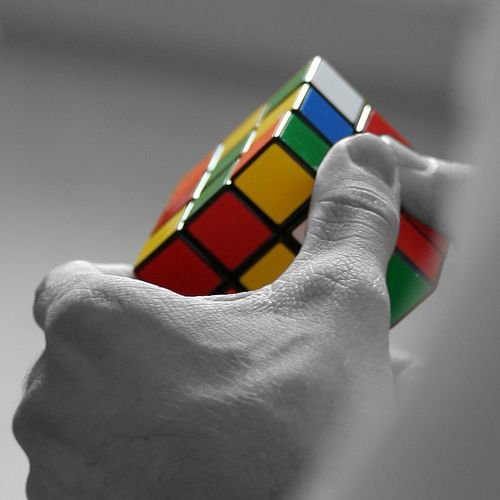Not too long ago, I was with my son in the local toy store helping him pick something he could spend some gift money on. Rather quickly he decided on a Rubik’s Cube. The flashbacks started rolling in…
The first time Rubik’s Cube was all the craze (circa 1980), I had one like everyone did. I was good at solving one side and maybe a second side, but that was about it. I could not get my head around the sequences (which I now understand are algorithms) to successful completion. I became quite proficient at one of the alternate solutions, namely popping out the pieces and assembling the cube solved. This worked for me and I was quite happy about it, too.
Fast forward to 2009 – Rubik’s Cube now comes with a little “cheat sheet” with directions on how to solve the cube. This little pamphlet is deceiving – small does not equal simple. To solve the cube, you have to understand the sequence of steps, carefully execute the algorithms (which vary depending on the current state of the cube), and trust yourself to move forward despite the disarray the cube may appear to be in. Over the course of a few days, numerous hours, and much chanting aloud of sequences such as “right inverse, down inverse, right, down,” I did it! It was one of those personal victories that you want to shout about from the rooftop, but no one really cares all that much about. I reveled in my personal milestone, and carefully (and still very slowly) repeated the victory a few times.
So what is the moral of this story? We are all in various stages of learning throughout our lives. We are all good at some things, and not so good at some things. We all need various levels of support in our quest for learning. However, there is NOTHING impossible given the right environment with regards to learning. I do not think I have inherent ability with regards to the Rubik’s algorithms, but now that I understand what they are, I can (with much practice) reproduce them and use them as a foundation for other experiences. Could I have done the cube without specific, clear directions and answers? Most likely not; Have I learned more than I ever would have otherwise? Absolutely! The students that sit in our classes every day have some predisposition to either “get it” or “not get it,” regardless of the particular content area. How we choose to support them is central to their success.
All students have to get from point a to point b in their learnng…some need a detailed map, and some just need us to stay out of the way. For me, it only took 30 years and a clear set of directions to understand Rubik’s algorithms. There are some who inherently understand them within a few minutes. I’m jealous of them, but I don’t care, because I can do it myself now. 🙂
Maybe I’ll try one of the 4X4 Rubik’s Cubes next…
Epilogue for the 21st Century: I was delighted that the cube had that cute little pamphlet with instructions. I painstakingly worked through it, re-reading many steps for clarity. I shared my experiences with others: their response to my endeavor? They looked up the solution on YouTube. I guess I still have a glaring ability to be a dinosaur…
Photo courtesy of Caramdir on Flickr.
